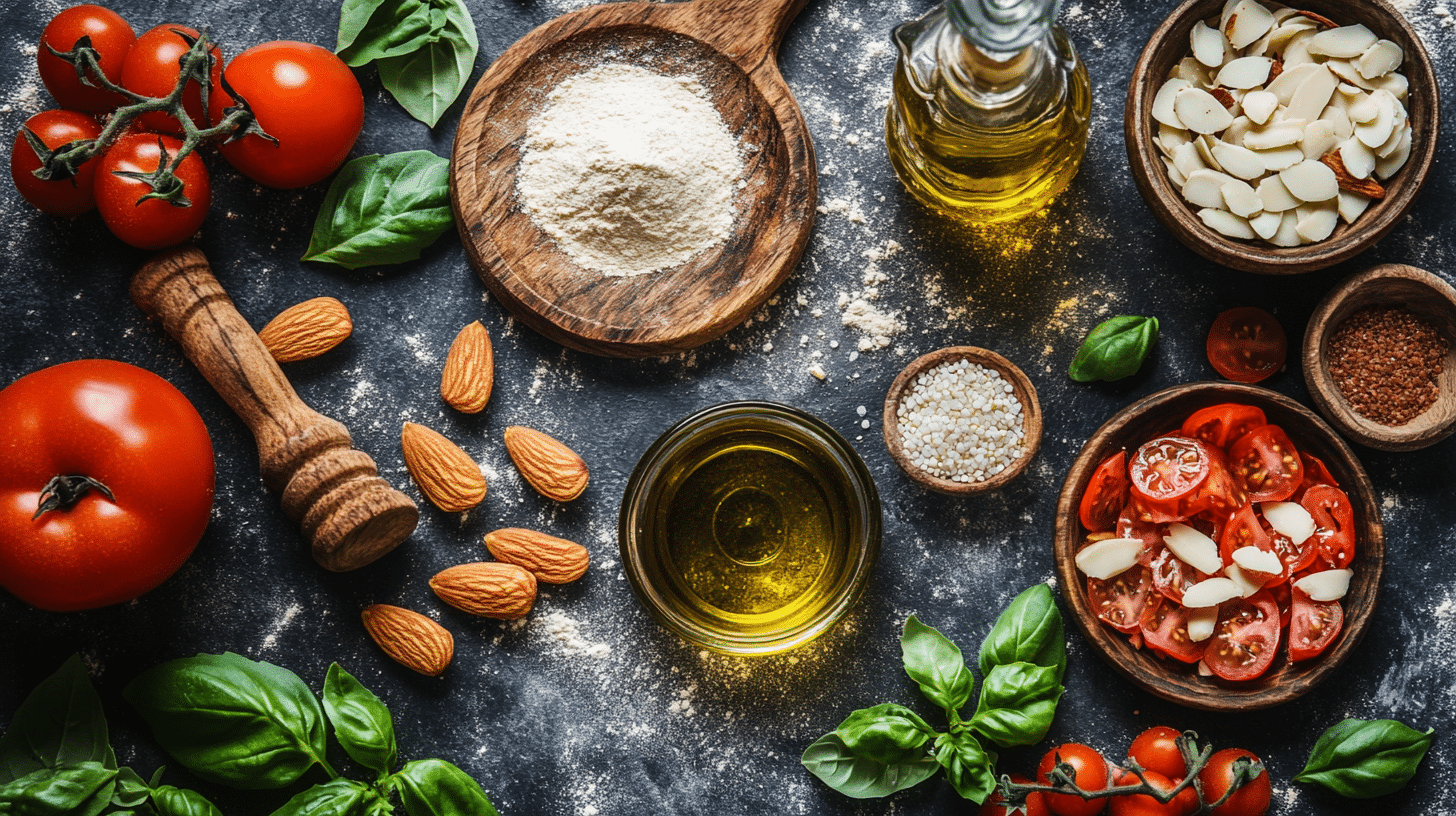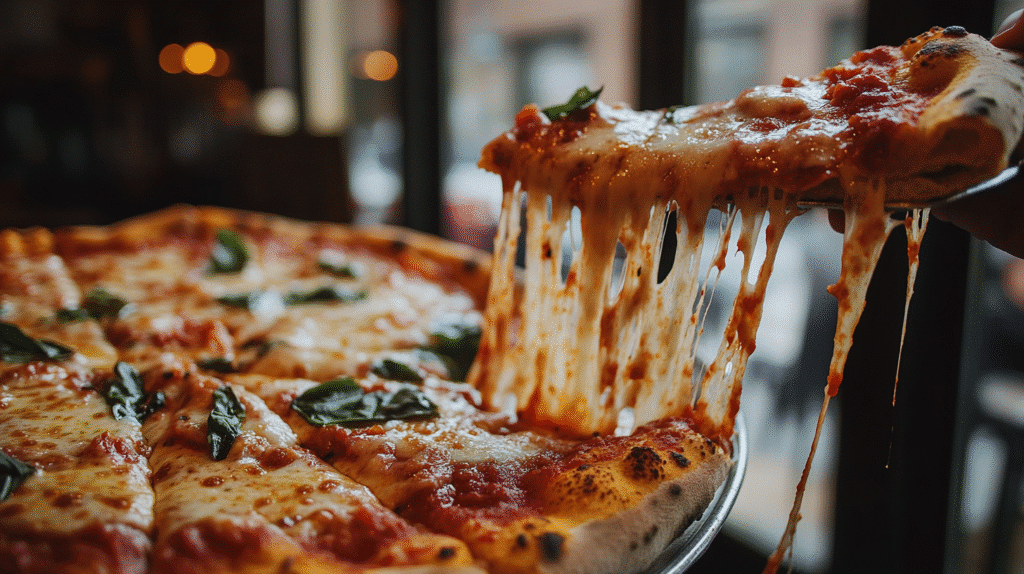If you’ve been craving a delicious pizza night without the gluten, you’re in the right place. Whether you’re avoiding gluten for health reasons or simply exploring new dietary options, gluten-free pizza gluten free can be just as satisfying as its traditional counterpart. From crispy homemade crusts to frozen favorites and restaurant-quality pies, there’s a world of gluten-free pizza waiting for you to discover.
In this guide, you’ll find everything from easy recipes to expert tips, plus answers to the most common questions about gluten-free pizza gluten free. We’ll walk you through the best crust options, how to make your pizza both gluten and dairy-free, and where to find the best gluten-free pizza in cities like Chicago.
So grab your apron, preheat that oven, and get ready to enjoy a slice (or two) of pizza that fits your lifestyle perfectly.

Table of Contents
In This Recipe
Understanding Gluten-Free Pizza
What Is Gluten-Free Pizza Made Of ?
Gluten-free pizza swaps out traditional wheat flour for a mix of gluten-free alternatives such as rice flour, almond flour, tapioca starch, or a blend of these. These flours mimic the texture and structure of wheat-based doughs, allowing you to enjoy a slice without triggering gluten sensitivities or celiac disease. (The Sourdough Science explains how gluten-free pizza can be both healthy and delicious with the right ingredients.)
Common binding agents like xanthan gum or psyllium husk are often added to give the dough its stretch and elasticity. The result is a crust that can range from thin and crispy to soft and chewy, tailored to your preference.
Health Benefits of Gluten-Free Pizza
Going gluten-free isn’t just about avoiding wheat; it can offer several health benefits, especially if you have celiac disease, non-celiac gluten sensitivity, or certain digestive conditions. gluten-free pizza gluten free can:
- Reduce bloating and digestive discomfort
- Support better nutrient absorption
- Lower inflammation in sensitive individuals
Keep in mind that gluten-free doesn’t automatically mean healthy. Ingredients and preparation still matter opting for whole food toppings and homemade sauces keeps things nutritious.
Is Gluten-Free Pizza FODMAP Friendly?
Many gluten-free pizza gluten free recipes and products can be low FODMAP, but not all are. To make a gluten-free pizza FODMAP-friendly, avoid high-FODMAP ingredients like garlic, onions, and certain cheeses. Stick to aged cheeses like cheddar or dairy-free alternatives, and always double-check sauces for hidden ingredients.
If you’re following a strict low-FODMAP diet, homemade is usually your safest bet. You control the ingredients, which helps avoid any gut-irritating surprises.
Crafting the Perfect Gluten-Free Pizza Crust

Gluten-Free Pizza Crust Recipes
PrintCrispy Homemade Gluten-Free Pizza (With Dairy-Free Option)
Enjoy pizza night without the gluten or the dairy! This simple, crispy gluten-free pizza crust is made with wholesome ingredients, perfect for sensitive stomachs and health-conscious eaters. Customize with your favorite toppings and cheese alternatives!
- Prep Time: 15 min
- Cook Time: 25 min
- Total Time: 40 min
- Yield: 1 medium pizza 1x
- Category: Gluten-Free, Dairy-Free, Vegan-Option
- Method: Easy
- Cuisine: USA
- Diet: Vegan
Ingredients
For the Crust:
1 ½ cups gluten-free flour blend (with rice, tapioca, potato starch)
1 tsp instant yeast
1 tsp psyllium husk or xanthan gum
¾ cup warm water (110°F)
1 tbsp olive oil
1 tsp apple cider vinegar (optional, for texture)
½ tsp salt
For the Toppings:
⅓ cup tomato sauce (check for hidden gluten)
½ tsp dried basil
½ tsp garlic powder
½ cup vegan mozzarella (or regular, if not dairy-free)
Your choice of toppings: mushrooms, olives, arugula, roasted veggies
Instructions
Activate Yeast: Mix warm water and a pinch of sugar with yeast. Let bloom for 5–10 minutes.
Make the Dough: Combine flour, binder, and salt. Add yeast mixture, oil, and ACV. Mix until sticky dough forms.
Let Rise: Cover and let dough rise in a warm spot for 30–60 minutes.
Shape & Prebake: Press dough onto parchment-lined pan or stone. Bake at 425°F for 10 minutes.
Top & Finish: Add sauce, seasonings, cheese, and toppings. Bake an additional 10–15 minutes until golden and bubbly.
Serve: Slice, serve hot, and enjoy with a salad or veggie side!
Notes
This gluten-free pizza is lower in cholesterol and saturated fat compared to traditional versions. It’s rich in plant-based ingredients, naturally dairy-free when using vegan cheese, and ideal for those following anti-inflammatory or gut-friendly diets.
Nutrition
- Serving Size: 2–3
- Calories: 290–320 kcal
- Sugar: 2g
- Sodium: 420mg
- Fat: 10g
- Saturated Fat: 1.5g
- Unsaturated Fat: 7g
- Trans Fat: 0g
- Carbohydrates: 42g
- Fiber: 4g
- Protein: 6g
- Cholesterol: ~10mg
The foundation of a great gluten-free pizza gluten free is, of course, the crust. There are countless variations, but the key is finding the one that suits your taste and texture preferences. A basic recipe often includes a blend of gluten-free flours (like rice, potato, and tapioca), yeast for rise, olive oil, and a binding agent like xanthan gum.
If you’re going dairy-free too, skip any milk powder and opt for non-dairy yogurt or water in your mix.
For a reliable, easy dough, we recommend this Gluten Free Pizza Crust, it’s simple, flexible, and delivers a beautifully crisp base.
Best Gluten-Free Pizza Crust Brands
Short on time? These ready-made gluten-free pizza crusts are popular for good reason:
- Against the Grain Gourmet – chewy, cheesy, and grain-free
- Simple Mills Almond Flour Crust – paleo-friendly and lightly nutty
- Capello’s Naked Pizza Crust – grain-free and perfect for thin-crust lovers
- Udi’s Gluten Free Crust – widely available and easy to customize
Look for options labeled gluten-free and dairy-free if needed. Always check for cross-contamination warnings if you’re highly sensitive.
Tips for a Crispy and Chewy Crust
- Pre-bake the crust: Bake your dough for 8–10 minutes before adding toppings. This helps prevent a soggy center.
- Use a pizza stone or steel: These help distribute heat evenly, giving your crust a golden, crisp bottom.
- Hydrate the dough: A wetter dough often results in a better texture don’t be afraid of a slightly sticky mix.
- High heat is key: Bake at 475°F or higher for that pizzeria-style finish.
Exploring Gluten and Dairy-Free Pizza Options
Dairy-Free Cheese Alternatives
Just because you’re skipping dairy doesn’t mean you have to miss out on cheesy goodness. Today’s dairy-free cheeses are more flavorful and melty than ever. Popular options include:
- Cashew cheese – creamy and homemade-friendly
- Coconut-based mozzarella – mild taste and good melt
- Almond cheese – nutty and rich
- Soy-free vegan shreds (like those from Miyoko’s or Violife) – allergen-conscious and flavorful
Tip: Look for brands that melt well and don’t rely too heavily on coconut oil, which can sometimes overpower the flavor.
Gluten and Dairy-Free Pizza Recipes
Creating a delicious gluten-free dairy-free pizza starts with simple, whole ingredients. Here’s a quick overview of how to build yours:
Crust: Use a gluten-free flour mix with water, yeast, olive oil, and a binder like psyllium husk
Sauce: Tomato sauce seasoned with garlic powder, basil, and oregano
Cheese: Top with vegan mozzarella or cashew cream
Toppings: Roasted veggies, olives, arugula, or even dairy-free pesto
These pizzas are surprisingly filling and can satisfy even the biggest cheese lovers.
Nutritional Benefits
Choosing gluten and dairy-free options can help reduce inflammation, support gut health, and may ease skin or digestive issues for some. When made with whole ingredients, these pizzas are:
- Lower in saturated fat
- Rich in plant-based nutrients
- Naturally cholesterol-free
Best Gluten-Free Pizza Brands
If you’re not up for making it from scratch, these gluten-free pizza brands deliver big on flavor:
- California Pizza Kitchen (GF line) – Crispy crust, bold toppings, widely available
- Amy’s Kitchen Gluten-Free Pizzas – Organic ingredients, great vegetarian and dairy-free options
- Daiya Gluten-Free Dairy-Free Pizzas – Fully plant-based, allergen-conscious
- Against the Grain – Unique texture with a cheesy, bread-like crust
Each of these brands balances taste with dietary needs, making them great staples for busy nights.
Gluten-Free Frozen Pizza Options
Frozen doesn’t have to mean boring. In fact, some of the best gluten-free pizzas live in the freezer aisle:
- Capello’s Almond Flour Pizza – Grain-free, paleo, and protein-packed
- Caulipower Pizzas – Cauliflower crusts that are surprisingly crispy
- Banza Chickpea Crust Pizzas – High-protein, high-fiber, and delightfully nutty in flavor
Keep a few on hand for fast, no-fuss dinners just add a side salad and dinner’s done.
Gluten-Free Pizza Rolls
Missing those classic pizza rolls? Gluten-free versions exist and they’re tasty!
- Feel Good Foods Gluten-Free Pizza Bites – Crispy exterior, gooey cheese center
- Totino’s Gluten-Free (limited markets) – Check local stores for availability
- Or try making your own: use gluten-free puff pastry or dough, roll with fillings, and bake until golden.
For more snackable recipes, check out our Gluten-Free crackers.
Gluten-Free Pizza in Chicago: Where to Find the Best

Top Gluten-Free Pizza Restaurants in Chicago
Chicago might be famous for its deep-dish, but gluten-free options are booming. Here are local spots known for their gluten-free pies:
- Lou Malnati’s – Offers a thin crust gluten-free pizza gluten free with signature sausage or veggie toppings
- Chicago’s Pizza – Known for both gluten-free deep dish and thin crust
- Spacca Napoli – Neapolitan-style gluten-free crusts made fresh in-house
- Pie Life Pizza – Creative toppings and vegan/gluten-free combos available
These places take care to prevent cross-contamination, but always call ahead if you have celiac disease or severe sensitivity.
Local Favorites and Hidden Gems
Beyond the big names, these hidden gems are worth a detour:
- Craft Pizza in Wicker Park – Thin, crispy crusts with lots of topping choices
- Bacci Pizza – Offers large, gluten-free slices upon request
- Kitchen 17 – Fully vegan spot with killer gluten-free deep-dish options
Local tip: Many neighborhoods have gluten-aware restaurants just search “gluten-free pizza near me” in Google Maps and filter by user reviews mentioning “celiac” or “cross-contamination.” (According to Green Lantern Pizza, gluten-free pizza is a great option for those with gluten sensitivity or celiac disease.)
Ordering Tips for Gluten-Free Diners
Dining out gluten-free can be a breeze with the right strategies:
- Ask about dedicated ovens or prep areas
- Avoid toppings like breaded chicken or processed meats unless labeled gluten-free
- Stick with simpler ingredient combinations
- Politely confirm with staff how they handle gluten-free orders
Homemade Gluten-Free Pizza: Tips and Tricks
Essential Ingredients for Homemade Gluten-Free Pizza
Crafting the perfect gluten-free pizza gluten free at home starts with a solid lineup of ingredients:
- Gluten-free flour blend – Look for mixes with rice flour, tapioca starch, and potato starch
- Yeast – Helps create rise and flavor
- Olive oil – Adds richness and helps with crisping
- Binding agents – Xanthan gum or psyllium husk are musts for structure
- Optional: Apple cider vinegar – Can enhance dough elasticity
If you’re dairy-free too, opt for water or non-dairy yogurt instead of milk in the dough.
Step-by-Step Cooking Guide
- Activate the yeast – Mix warm water (about 110°F) with a bit of sugar and let the yeast bloom
- Mix the dough – Combine dry ingredients, add wet ingredients gradually, mix until smooth
- Rest and rise – Let dough rest in a warm place for 30–60 minutes
- Shape the crust – Use oiled hands or parchment to press the dough onto a pizza stone or baking sheet
- Par-bake – Prebake the crust at 425°F for about 10 minutes
- Add toppings – Layer sauce, cheese, and toppings of choice
- Final bake – Bake another 10–15 minutes until crust is golden and cheese is bubbling
This method gives you a solid, crispy base every time.
Common Mistakes to Avoid
- Skipping the binder – Without xanthan gum or psyllium, your dough will crumble
- Overbaking – Gluten-free crusts dry out quickly; watch your oven closely
- Too much flour – Gluten-free doughs are wetter than wheat doughs don’t over-correct
- Not pre-baking – Skipping the prebake leads to soggy crusts
Test different flour blends and don’t stress if the first batch isn’t perfect it’s all part of the fun.
FAQs: Answering Your Gluten-Free Pizza Questions
What Is a Gluten-Free Alternative to Pizza?
If you’re avoiding gluten altogether, there are plenty of delicious alternatives:
Cauliflower crust pizza – Made from grated cauliflower, cheese, and egg
Chickpea crust (socca) – Savory and protein-rich
Polenta pizza base – Great for firm, thick slices
Sweet potato crust – Adds a naturally sweet, hearty base
These substitutes not only ditch the gluten, but also bring new flavors and textures to your pizza night.
Are Gluten-Free Pizzas Healthy?
They can be healthy especially if you make them at home. Gluten-free crusts tend to be lower in fiber and protein unless boosted with whole grains or legumes. Store-bought versions may contain more starch and oil.
To keep your pizza healthy:
Use whole food toppings like fresh vegetables and lean proteins
Go easy on sugary sauces
Add fiber-rich sides like a salad or roasted veggies
Why Does Gluten-Free Pizza Taste Different?
Gluten-free dough lacks the elasticity that gluten provides, which can change both texture and flavor. You might notice:
A slightly denser or crispier crust
A more neutral or earthy flavor, depending on the flour used
Less chewiness
That said, a well-balanced dough can taste every bit as satisfying as traditional pizza.
Can I Eat Gluten-Free Pizza on a Diet?
Absolutely! gluten-free pizza gluten free fits into many diets, including:
Low-carb (with cauliflower or almond flour crusts)
Low-FODMAP (when made without garlic, onions, or dairy)
Plant-based (with vegan cheese and veggie toppings)
Control portion sizes, load up on veggies, and pair with a side salad to keep it light
Can I Eat a Slice of Pizza Every Day and Lose Weight?
Yes, but it’s all about balance. If you’re eating one moderate slice within your daily calorie needs and your other meals are nutrient-dense pizza can still be part of a weight-loss plan. Just be mindful of high-calorie toppings and portion sizes.

Conclusion
Gluten-free pizza doesn’t have to be a compromise it can be a flavorful, satisfying, and nourishing meal that fits right into your lifestyle. Whether you’re baking your own crust from scratch, picking up a frozen favorite, or grabbing a slice in Chicago, there are more delicious options today than ever before.
From understanding the basics of gluten-free ingredients to mastering a crispy crust or exploring dairy-free alternatives, you now have everything you need to enjoy pizza night your way.
Remember, the best gluten-free pizza gluten free is the one you enjoy most, so don’t be afraid to experiment, taste, and tweak until it’s just right.
Love discovering nourishing and simple recipes? Follow Vivalyze on Facebook for daily kitchen inspiration and practical wellness tips.
Curious about feel-good, health-boosting recipes and drinks? Check out Vivalyze on Pinterest for a curated collection of delicious ideas.

